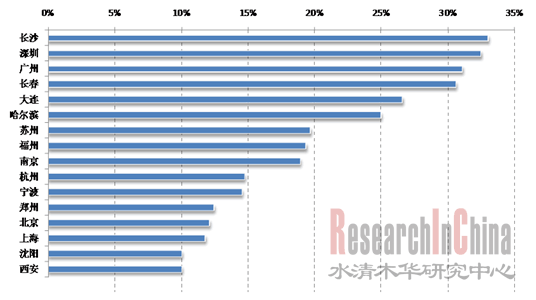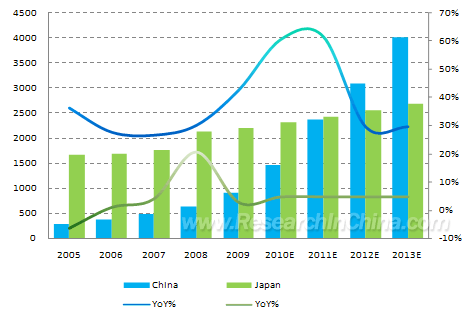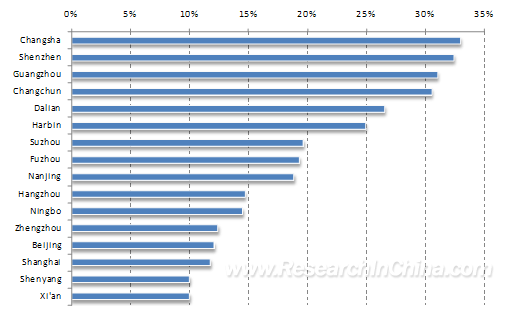中国电影产业迎来了黄金时期,产业各个环节,无论是制片、票房、融资还是影院建设,均呈现飞跃发展的良好态势。
2009年中国内地实现62.06亿电影票房,过去5年中国内地票房以年均30%的速度增长,远超过中国GDP增速,2009年增速更是高达43%。
2010年上半年,中国电影票房收入突破48亿元,超过2008年全年票房,比2009年同期增长107%,再一次验证了中国市场的巨大潜力。
2010年年初,国务院颁布《关于促进电影产业发展繁荣的指导意见》,第一次明确把电影产业提高到国家战略产业的高度。
08和09年中国电影市场的火爆,使得资本不断涌向电影产业。中国电影产业在2010和2011年将保持60%以上的高增长, 2012年后的增速会有所放缓。而日本电影市场已经趋向饱和,增速也趋于平缓。因此如下图所示,中国国内票房将在2012年底超过日本,成为全球第二大电影市场。
图:2005-2013中日电影票房规模及增速对比(单位:百万美元)
数据来源:水清木华研究中心
电影业的制片商与发行放映商均有向上、下游延伸的趋势,力图以“制片+发行+院线”的模式赚足每个环节的利润。为了实现利润的最大化,资本推动上、中、下游的领先企业间合并。中影、上影等国有企业依然凭借其优势地位加紧院线和影院建设,且有望在2010年上市,获得更多资金。华谊兄弟于已于2009年上市,成为民营电影公司中的老大。作为发行公司的保利博纳不仅涉足影院建设,也向上游制片业发展,以期更大利润。
中国电影制片市场还出现了一批新的投资主体。特别是如完美时空投资的《非常完美》,乐视网络投资的《决战刹马镇》等电影的票房成功,引领业外资本大举进入电影制片领域。
中国电影制片市场集中度还不高,中影、华谊分别以10%和9%的份额占据中国制片市场的第一、二位。中国四大制片公司的票房总份额(26%)不抵美国三大制片公司在中国的票房份额(27%)。
中国电影发行市场相对垄断,票房集中度高。2009年,中影、华夏、保利博纳、西影华谊四大发行公司市场占比75.7%,进口分账片仍只能由中影和华夏发行,中影凭借广泛的院线资源,继续领跑发行市场。
院线方面,市场集中度相对集中,排名前四位的院线——万达、中影星美、上海联和、北京新影联票房份额达46.8%。其中,由于万达院线有万达商业为支撑,占得核心商圈的先机,以每年增加100块银幕的速度扩张。
伴随着电影票房火爆增长的同时, 2009年的465部国产电影中,只有约130部进入院线放映,其余2/3的影片没能在影院放映。造成这种矛盾的主要原因是中国的影院及银幕数量依然偏少,未能形成足够的放映空间以容纳更多的影片。因此影院投资将长期成为电影产业发展的主题。
虽然北京、上海、广州等一线城市电影票房增势依然迅猛,仍然有很大的影院投资空间。但是,激烈的竞争也随之而来。相比之下二、三线城市如长春、长沙、大连、西安等城市也已开始崛起,市场潜力巨大。我们综合考虑城市居民消费水平、影院票房表现、城市常住人口、单场观影人次、以及当地房价、影院数、银幕数等影响影院投资地点的因素,建立影院投资评估模型,得出十六个城市的投资价值排名,如下图所示:
图:2010年中国16城市的影院投资价值排名 
数据来源:水清木华研究中心
本报告对中国电影产业链上的各个环节——制片市场、发行市场、放映市场、衍生品市场的概况、竞争格局及相关重点企业做了详尽分析,并对影院建设热点城市、电影衍生品市场做出预测。
Currently, China’s film industry is experiencing a golden period. No matter what film production, box office, financing and cinema construction witness the explosive growth.
In 2009, Chinese mainland achieved RMB6.206 billion of film box office, with a growth rate of as high as 43%. Over the past five years, it grew at a CAGR of 30%, far higher than that of China’s GDP.
In H1 2010, the film box office in China exceeded RMB4.8 billion, rising 107% from that in the same period of 2009, and surpassing that of the year 2008, showing hug potentials of Chinese film market.
In early 2010, the State Council Secretariat Guiding Opinions Concerning Stimulating Flourishing and Development of the Film Industry was issued to firstly specify the film industry into national strategic industries.
The boom of China’s film market during 2008-2009 has spurred the flood of capital into the film industry. The film industry of China will continue to grow at a rate of over 60% both in 2010 and 2011, while the growth rate will slow down after 2012. In Japan, the film market gets increasingly saturated, and the growth rate tends to be moderate. As is presented below, China will become the world’s second largest film market by 2012, with the domestic box office revenue surpassing Japan’s.
Comparison of China's and Japan’s Box Offices and Growth Rates, 2005-2013E (Unit: USD mln) 
Source: ResearchInChina
The film producers, distributors and exhibitors all have extended towards upstream or downstream in order to maximize its profit from every industrial link by the model of production+distribution+cinema. The mergers among leading companies in upstream, middle stream and downstream are driven by capital to achieve maximal margin. The state-owned companies like China Film Group Corporation (CFGC) and Shanghai Film Group Corporation are accelerating to build cinemas and cinema circuits by their advantageous positions, and they are expected to go public in 2010 to obtain more fund. Huayi Brothers Media Corporation, the leader in private film firms, was successfully listed in 2009. Poly Bona, a film distribution company, not only participates in cinema construction, but also develops towards the upstream production to make more profit.
Meanwhile, a group of new investment entities presented themselves in Chinese film production market. Especially, the box office success that Perfect World and Letv.com respectively invested Sophie's Revenge and Welcome to Shamatown achieved has attracted foreign capital to aggressively enter the film production sector.
China’s film production market characterizes still a low concentration degree. CFGC and Huayi Brothers, respectively ranking the first and the second places, only occupies 10% and 9% market shares. Meanwhile, China’s top four film producers only accounts for 26% of total film box office, still less than that of the United States’ three producers in China, 27%.
However, the film distribution market of China is comparatively monopolized, with a higher concentration degree in box office. In 2009, the top four film distributors, CFGC, Huaxia Film Distribution, Poly Bona and Xiying Huayi occupied 75.7% market shares in all, and revenue-sharing imported film could be only distributed by CFGC and Huaxia Film Distribution. CFGC continued to take a lead in distribution market by right of its rich cinema circuit resource.
China has a relatively high concentration degree in cinema circuit field, since the top four, Wanda International Cinema, China Film Stellar Theater Chain, Shanghai United Circuit and New Film Association, totally covers 46.8% of box office shares. Of which, backed by Wanda’s business, Wanda cinema circuits have seized the central business district, and increases 100 screens annually.
Along with the explosive growth of film box office, only approximately 130 films of the total 465 China-produced films were exhibited in cinemas in 2009, and the rest 2/3 were not, which was mainly caused by the inadequacy of cinemas and screens that couldn’t afford to exhibit so many films. Therefore, cinema investment will be the focus of China’s film industry development in a long run.
In spite of the strong growth of film box office revenue in first-tier cities like Beijing, Shanghai and Guangzhou as well as still vast room for cinema investment, the fierce competition also get increasingly intensified. In comparison, the emerging second-tier and third-tier cities such as Changchun, Changsha, Dalian and Xi’an grow up and all have great market potential. Based on the analysis of comprehensive factors like consumption level of urban residents, cinema box office, regular urban population, audience number per exhibition, local housing price, cinema number and screen number, the cinema investment rating model is built to conclude the ranking of top 16 cities in China by investment value, as is shown below.
China’s Top 16 Cities by Cinema Investment Value, 2010 
Source: ResearchInChina
The report makes an in-depth analysis of status quo, competition layout and major companies of production, distribution, exhibition and derivative commodities of China’s film industry chain, and forecasts cinema construction in hotspot cities, and film derivative market.